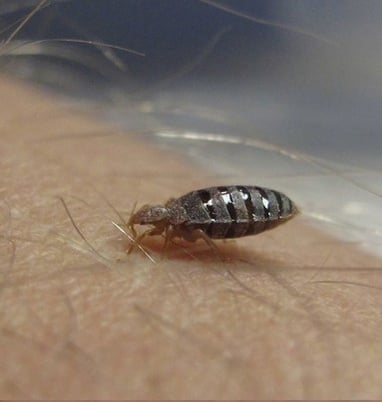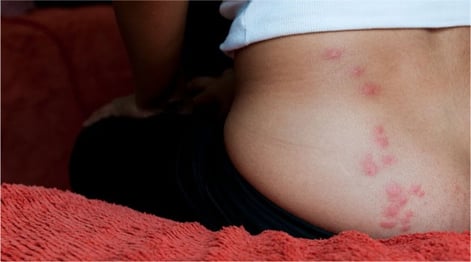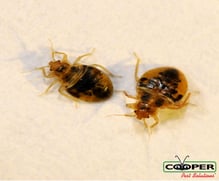No Bugs and No Bites. No Prep required. 100% Guaranteed to Get Rid of Bed Bugs
Bed Bug Library Shortcuts
How does a person get bed bugs?
How can I get rid of bed bugs in my apartment?
Do bed bugs have a color preference?
What's the difference between bed bug and bat bug bites?
How to Avoid Bringing Home Bed Bugs From Vacation
How does Cooper get rid of bed bugs?
How do I know if I have bed bugs?
I think I have an infestation. What can I do?
Can cleaning companies get rid of bed bugs?
Is it necessary to prepare my home before a bed bug treatment?
Can bed bugs live in the winter?
How long does it take to get rid of bed bugs?
How can I tell if I have bed bugs?
How does a person get bed bugs?
Bed bug infestations spread when an individual comes into contact with bed bugs and unknowingly brings them somewhere else. They are transported as stowaways, hiding in luggage, couches, beds, pillows, or backpacks to name a few. Bed bugs cling to moving items like briefcases and can easily fall off, allowing them to relocate and spread. It’s also a common occurrence that bed bugs lay eggs on these items. As the host moves, they can fall off and hatch far away from where they originally came from.
To read more about bed bug infestations, click here.
How can I get rid of bed bugs in my apartment?
Bed bugs are not a pest that you should try to control on your own. Attempting to resolve the issue yourself as improper treatment could spread the problem throughout and increase costs to eliminate the problem. If you live in an apartment complex and suspect you have bed bugs you should immediately contact your landlord so they can notify the pest control company in charge of the complex.

You should AVOID discarding bedding and mattresses. This is not a solution and can spread the infestation throughout the house, and any new furniture can quickly become infested.
Use a vacuum but that has a crack and crevice attachment to remove bugs from the mattress, box spring and bed frame. As soon as you are done, the vacuum bag should be sealed in a plastic garbage bag and disposed of in an outdoor trash receptacle.
Residents can also purchase bed bug proof encasements that can be used to encase both the mattress and box spring in order to salvage beds that are infested. Once encased, any bed bugs that were not removed by the vacuum will become trapped inside where they will starve and eventually die.
To learn more about bed bug treatments in apartment units, click here.
Do bed bugs have a color preference?
New research is constantly being conducted to find out more about these parasites that are infesting cities across the country. A study performed by the researchers at University of Florida and Union College in Lincoln, Neb., wanted to explore if bed bugs had a color preference for their hiding places.
According to the study, the researchers created small tent-like harborages made from different colored card stock and placed them in Petri dishes. A bed bug was then placed within the dishes and had approximately 10 minutes to choose one of the colored harborages. Results of the study showed that bed bugs strongly preferred red or black colors versus colors like yellow or green.
Cooper Pest Solutions’ staff Entomologist and bed bug expert, Dr. Richard Cooper, believes that the findings of this study may implicate that bed bugs are attracted to darker colors because of the contrast it provides against the environment.
“The color preference has to do with their orienting to vertical and darker objects,” he said. “That may be an adaptation to identify beds and upholstered furniture because these are vertical objects that stand out and have contrast against the surrounding environment. What we believe is that they are detecting contrasting objects in an environment and orienting towards them.”
Read more on this study by clicking here.
What's the difference between bed bug and bat bug bites?
Bed bugs and bat bugs look almost identical in body shape and color, but the key difference is the bat bug’s hair length is longer on the upper covering of their thorax. It is very difficult to see this without the use of a microscope, so it is highly recommended that a trained professional makes the determination between bugs.

Another key difference of bat bugs and bed bugs is their location.
Most bed bugs can be found within a few feet of their feeding host, which includes mattresses, headboards, baseboards, and other furniture close by. Bat bugs may be seen in a few of these places as well, but are mainly found in areas that harbor bats, such as attics. They may be seen up on ceilings and on the walls, but usually stay within the vicinity of their food source.
Learn more about bed bug and bat bug differences by clicking here.
How to Avoid Bringing Home Bed Bugs From Vacation
In a survey by the National Pest Management Association (NPMA), 75% of pest control professionals indicated that they have encountered infestations of bed bugs in hotels and motels. The NPMA recommends the following tips for bed bug prevention when traveling:
-
At hotels, pull back the sheets and inspect the mattress seams, particularly at the corners, for telltale stains or spots. If you see anything suspect, notify management and change rooms/establishments immediately.
-
Thoroughly inspect the entire room before unpacking, including behind the headboard and in sofas/chairs. If any pests are spotted, change rooms/ establishments immediately
-
If you do need to change rooms, be sure that you do not move to a room adjacent and/or directly above/below the suspected infestation. Bed bugs can easily hitchhike via housekeeping carts, luggage and even through wall sockets. If the infestation is spreading, it typically does so in the rooms closest to the origin.
-
Consider placing your suitcase in a plastic trash bag or protective cover during the duration of your trip to ensure that bed bugs cannot take up residence there prior to departure
-
Remember: bed bugs travel by hitching rides. After your trip, inspect your suitcases before bringing them into the house. Vacuum your suitcase thoroughly before storing away. Consider using a garment hand steamer to steam your luggage, which will kill any bed bugs or eggs that may have hitched a ride home.
-
Wash all of your clothes - even those that have not been worn - in hot water to ensure that any bed bugs that may have made it that far are not placed into your drawers/closet.
Read more tips about avoiding bed bugs on vacation by clicking here.
Bed Bug Treatment Pricing
Unfortunately bed bugs can often be difficult to detect and once you do recognize they are there, they can be even more difficult to get rid of. This is one of the few pests that you definitely want to hire a professional to address because trying to treat on your own is rarely successful and may result in spreading the bugs throughout of you home. Pricing depends upon the level of infestation in your home as well as the technician's time spent treating and the materials used.
If you suspect a bed bug problem in your home, please do not hesitate to call Cooper or fill out our form to schedule a free* inspection. To learn more about bed bug service pricing, click here.
*Conditions apply based on bed bug activity and we reserve the right to charge $125 for inspections where bed bugs are not clearly present. May not be applicable for apartments depending on apartment type and ownership.
How does Cooper eliminate bed bug infestations?
Bed Bugs are incredibly difficult to get rid of, and it is almost impossible to accomplish without the help of a professional. Since bed bugs are capable of going months at a time without eating, it can be hard to tell if you have truly eliminated the problem without confirmation from an expert. Leaving your home or sleeping somewhere other than your bed will not get rid of bed bugs and often will cause them to spread to new areas.
Cooper Pest Solutions is equipped to carry out every step of the bed bug elimination process from proactive measures, to treating with pesticides and steam. Cooper′s highly skilled representatives and technicians will inspect your home for signs of a bed bug infestation and determine the severity of the infestation. Treatment will be carried out according to the needs of your particular situation. Unlike other companies, Cooper′s treatments do not require prep on your part.
To learn more about our No-Prep philosophy, click here.
How do I know if I have bed bugs?
The most reliable way to confirm you have bed bugs is to contact Cooper Pest Solutions to identify a sample collected from your home. However, there are key warning signs that you may have an infestation:
- Going to bed and waking with bites, welts or rashes. Bite marks may appear in a rows and clusters.
- Dark spotting or blood droplets on mattresses or bedding. These are waste products bed bugs excrete while digesting a blood-meal.
- Visible observation of eggs, molted insect skin, or the insect. The failure to locate an insect does not indicate they are not present. Adult bed bugs are difficult to locate, and immature bed bugs can be difficult to see due to their size.
I think I have an infestation, what should I do?

Upon discovering an infestation, immediately contact Cooper Pest Solutions to evaluate your problem. You should AVOID discarding bedding and mattresses as this can spread the infestation throughout the house and new furniture can quickly become infested. Also, AVOID attempting to resolve the issue yourself as improper treatment could spread the problem throughout and increase costs to eliminate the problem.
To learn more about our bed bug services, click here.
Can cleaning companies exterminate bed bugs?
Several companies provide cleaning services for bed bug infestations in NJ and PA. The services of the cleaning company are contracted by a homeowner or a pest control company before the arrival of a professional bed bug removal company (in most cases). The common misconception by some homeowners who suspect bed bugs is that these companies can get rid of active bed bugs without chemicals (or a pest control professional), and can simply clean out the bed bugs with their cleanup services.
The short comings of the bed bug cleaning service include vacuuming and putting linens into the dryer on high heat. While this will get rid of visible bed bugs, it still does not address the main areas where they live and breed. Another issue with cleaning companies is that

they often unknowingly mishandle linens. Shaking them or flinging them onto the floor can move the bed bugs and cause the infestation to relocate or even spread.
The approach that most professional bed bug cleaning companies take is not to get rid of bed bugs, but instead, to prepare your bedroom for professional bed bug pest control. While reducing clutter, vacuuming the room, and putting pillows and bedsheets into a dryer on high heat can help with bed bug infestations, it’s not a substitute for professional bed bug pest control. Some people reach out to cleaning companies in hopes of avoiding treatments from pest control companies which can be pricey (depending on the severity of the infestation) and also trying to avoid pesticides (something we will go into later.) Unfortunately, there is no “quick fix” or shortcut when it comes to effective bed bug elimination.
Read more about bed bug cleaning services by clicking here.
Is it necessary to prepare my home before a bed bug treatment?
Most pest control companies will require that you do significant prep work on your own time, without their help, before they even begin service. The actions they require differ based on the type of treatment as well as the type of residence. Leaving preparation in the hands of the client can lead to a myriad of problems that pest control companies are all too familiar with.
Below is a sample checklist for clients to complete before their bed bug service begins. We’ve created the list from several other pest control companies in the New Jersey and Eastern Pennsylvania area.
- Lift mattresses and box springs out of the bed frame and stand them up against a wall.
- Empty all closets and dressers.
- Wash and dry all clothing within the room on high heat.
- Bag all personal items that cannot be laundered.
- Empty all luggage and travel bags into untied bags.
- Remove all sofa, chair, and other upholstered furniture cushions and accessories.
- Remove all sheets, blankets, pillowcases, and other bedcoverings from the mattress and box spring and dry for at least 50 minutes on high heat.
- Thoroughly vacuum your mattress, box spring, inside of dresser drawers, all carpeting throughout your entire home, floors, area rugs, sofas, futons, recliners, upholstered furniture, and physical bugs you may see.
- Remove and dry all curtains and window dressings on high heat.
- Inspect items that cannot be washed such as books, electronics, picture frames, and plastic toys. Place them into plastic bags only if you do not find bed bugs on these items.
- Reduce clutter under your bed and around the room.
- Encase your mattress using specialized mattress encasements.
Cooper's No-Prep Philosophy is how we deliver our bed bug services for our clients because we know the risks of moving bedding, clothing, and other stuff in the room can make additional treatments necessary, potentially causing you additional stress and money. Unlike other companies, our No-Prep Philosophy reduces the number of technician follow-up visits and expedites successful bed bug elimination in your home. No-Prep also means no bounce back. Some pest control companies will declare your home bed bug-free without eliminating the entire population. This results in the “bounce back” of bed bugs into your home after the service is complete. In cases like this, companies put their clients through bounce back due to lack of training or excessive prep work. With our deep knowledge of bed bugs and their biology and behavior, bounce back is not common.
To learn more about Cooper Pest Solutions' No-Prep Philosophy, click here.
Can bed bugs live in the winter?
Bed bugs begin to die at temperatures below 0°F. Exposure to this temperature has to be consistent for at least 4 days to kill off these adaptable pests. It’s not something that typically is achievable without a professional bed bug freezing control program from a reputable pest control company. Throwing your mattress or suitcase outdoors in the winter will not do the trick. The heat from direct sunlight and moisture that is naturally in the air won’t allow bed bugs to truly reach a freezing point. Opening up the windows to your house on an especially cold January day won’t help either.
Bed bugs do not hibernate. As a form of preservation, when faced with freezing temperatures, bed bugs can go into what’s called “diapause.” During this suspended state, bed bugs are more dormant than anything, preserving energy and halting development until conditions become livable again. Bed bugs do not live in colonies outdoors, so they usually don’t have to deal with extreme cold. Because they feed off of live, warm-blooded hosts that live indoors at comfortable temperatures, diapause is possible, but not something that’s frequently utilized or needed.
How long does it take to get rid of bed bugs?
The length of time that it takes to get a bed bug infestation under control depends on the methods used by the pest control technician.
Chemical Bed Bug Control- Pesticides can be used as a way to control and eliminate bed bugs in residential settings. Depending on the company and your needs, pesticides could be in the form of powder, liquid, and more. There isn’t a one-size-fits-all solution with pesticide usage. The amount of time that it will take to see full results vary by the method used.
Heat- Heat treatments are one of the strategies that pest control companies can use to get rid of bed bugs. Heat services involve the use of a unit that physically heats a room or entire house to at least 120 degrees Fahrenheit which is optimal for eliminating bed bugs. A heat trailer is stationed outside to provide power for the heating units, and fans are placed in the treated areas to circulate throughout the space to evenly heat all of the items in the room. According to the University of Minnesota, “Bed bugs and eggs die within 90 minutes at 118°F (48°C) or immediately at 122°F (50°C). During a heat treatment, the air temperature in the room is typically between 135°F (57.2°C) and 145°F (62.7 °C).”
Freezing- Bed bugs that are exposed to freezing temperatures can die. The colder the room, the quicker the treatment will work. Bed bugs begin to die once the temperature of a room passes below 0 degrees Fahrenheit, so it’s not as simple as opening your windows in the middle of January. According to the Entomological Society of America, “in order to achieve 100% mortality, a minimum exposure time of 80 hours at minus 16 degrees Celsius is required for all life stages. Temperatures below minus 15 degrees Celsius are sufficient to control all life stages of bed bugs after 3.5 days, while temperatures below minus 20 degrees Celsius require only 48 hours.” In short, the time frame for elimination is directly correlated to the temperature used. The lower the temperature, the quicker the service works.
No-Prep- Cooper Pest Solutions uses the No-Prep Method to control and remove bed bugs from residential homes. No-Prep uses a combination of chemical and non-chemical tools to get rid of the bed bugs in your home. Our technicians will use environmentally conscious pesticide dust to eliminate pests behind beds, switch plates, carpet tack strips, etc. Liquid pesticides are also applied to baseboards to exterminate any bed bugs that may be hiding there. In addition, we will steam two feet around the affected area to ensure that they are eliminated. With this method, clients do not have to move mattresses or heavy furniture. The No-Prep Method involves an average of 2-3 separate visits to the home to get rid of bed bugs completely. The number of treatments can vary per the severity of the infestation.
How can I tell if I have bed bugs?
One of the easiest ways to confirm bed bug activity is by analyzing the evidence that they leave behind. As they move about your bed at night, bed bugs poop, which causes staining. Light-colored or white bed sheets, pillows, and bed frames can easily reveal what looks like small marks from a pen or sharpie marker. This is fecal matter, which is a dead giveaway that bed bugs are active in your home.


